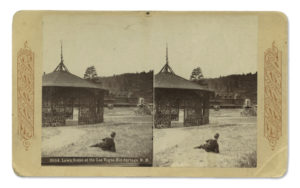Hot Topic
Exhibition Explores the History of Hot Springs

For Alicia Romero, curator of New Mexico and Nuevo mexicana/o history at the New Mexico History Museum, organizing a photo exhibition around hot springs in the state provided a much-needed ahhh moment amid the stresses of the pandemic.
Curative Powers: New Mexico Hot Springs opened March 18 in the museum’s Herzstein Gallery, bringing together 75 mostly historic photographs of hot springs, as well as retro maps, brochures and other promotional materials. While the photos depict ever-evolving sites of geothermal energy around New Mexico, Romero says their context provides other historical clues.
“It’s fun to look at the kind of people who frequented them, and the evolution of the architecture and infrastructure around them,” she says.
The exhibition also examines the role of hot springs in the development of tourism in New Mexico. Those who invested most in their development and marketing are also revealed. A hint? Romero gives a three-word clue: “Atchison, Topeka and Santa Fe” (as in Railway). One of the curator’s favorite photos on display depicts a late 19th century crowd, presumably just off a train, taking in the springs.
“These people are just kind of sitting in the hot springs that haven’t been quite developed in their beautiful Victorian clothing,” she laughs. She adds that Montezuma Hot Springs, with its proximity to the railroad in Las Vegas, appears to have been a hotspot for ladies in long dresses with parasols, and men with hats and tails, staring inscrutably into the camera.
Less than a century later, the people frolicking at area hot springs were a lot more, well, naked.
“Fast forward to photos of these hot springs in the ‘70s and ‘80s, and they’re all hippies,” Romero continues. “There’s no clothes, and it’s fun and loving. It’s so interesting to see the evolution in people’s behaviors.”
Curative Powers anchors several projects underway at the History Museum. Opening August 7 is an exhibition and related programming celebrating 100 years of Indian Market (1922-2022).
Some 150 objects documented to have been purchased at Santa Fe’s Indian Market over the past century are featured, including award-winning examples of pottery, jewelry, textiles, sculpture, basketry, paintings and beadwork. Over 100 historic and contemporary photographs and video interviews with Indian Market artists will also be on view. Museum of New Mexico Foundation members will get a sneak preview of the show on Friday, August 5.
Meanwhile, Romero is serving as project director for a recent $172,564 grant from the National Endowment for the Humanities American Rescue Plan to pursue research for a 2023 exhibition on Miguel Trujillo (Isleta). The project explores Trujillo’s victorious 1948 court case against the State of New Mexico to secure voting access for Native Americans living on tribal lands. The grant, co-written by Romero and Palace of the Governors Photo Archivist Hannah Abelbeck, supports additional staff and advisors for the exhibition, which is guest-curated by Porter Swentzell (Santa Clara).
As ever, private funding opportunities through the Museum of New Mexico Foundation are available.
“While we have the money to pay the great people we hired, we really need extra funds to help implement the exhibition, as well as for speakers and symposia,” Romero says.
To support exhibitions and public programs at the New Mexico History Museum, contact Yvonne Montoya at 505.216.1592 or Yvonne@museumfoundation.org.
This article is from Member News March 2022.
Image from: Continental Stereoscopic Company, Gazebo at Las Vegas Hot Springs, New Mexico, ca. 1878


Connect